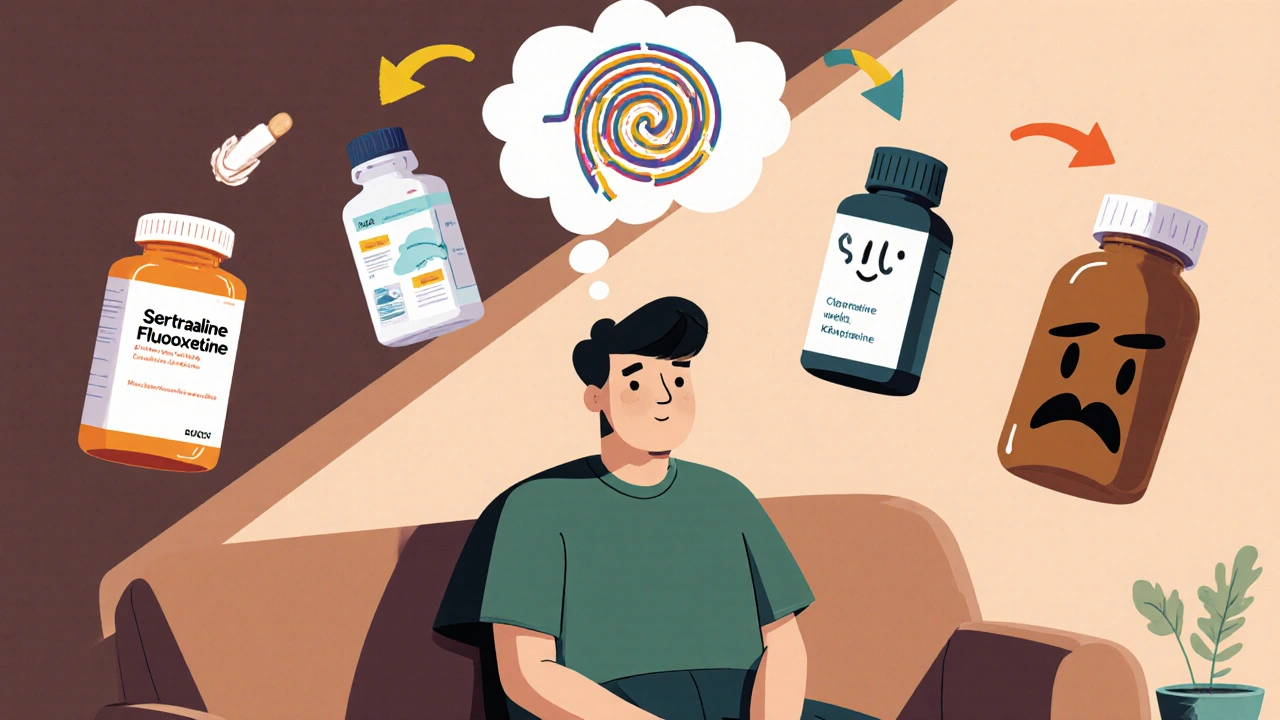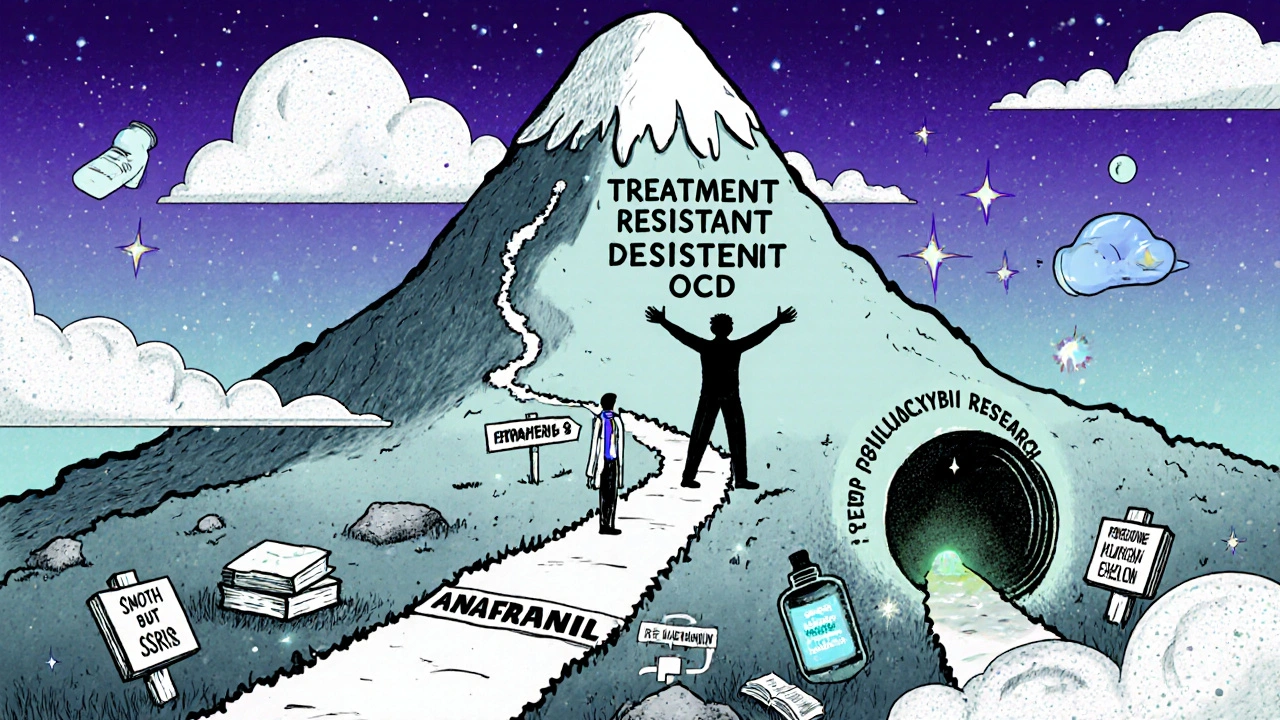OCD Treatment Comparison Tool
How to Use This Tool
Answer these questions to see which treatments might work best for your situation. This tool is based on the latest clinical evidence and recommendations from the article.
Your Situation
Recommended Options
Based on your responses, these treatments show the best balance of effectiveness and tolerability for your situation.
Anafranil (clomipramine) has been a go-to treatment for obsessive-compulsive disorder (OCD) and some forms of depression for decades. But it’s not the only option-and for many people, it’s not the best one. Side effects like dry mouth, dizziness, weight gain, and heart rhythm changes can make it hard to stick with. So what else is out there? And how do those alternatives stack up?
Why Anafranil Still Has a Place
Anafranil is a tricyclic antidepressant (TCA), and it’s one of the few medications approved by the FDA specifically for OCD. It works by boosting serotonin and norepinephrine in the brain. That dual action gives it an edge in treating severe OCD cases that don’t respond to other drugs. A 2022 meta-analysis in the Journal of Clinical Psychiatry found that clomipramine was slightly more effective than SSRIs for reducing OCD symptoms, especially in patients with intrusive thoughts or compulsive rituals.
But effectiveness doesn’t always mean tolerability. About 40% of people stop taking Anafranil within the first six months because of side effects. That’s why doctors often try other options first-unless the OCD is severe, treatment-resistant, or paired with depression that hasn’t budged with other meds.
SSRIs: The First-Line Alternative
For most people, SSRIs are the starting point. These include fluoxetine (Prozac), sertraline (Zoloft), fluvoxamine (Luvox), and escitalopram (Lexapro). They’re not as potent as Anafranil for OCD, but they’re much easier to tolerate.
Here’s how they compare:
| Medication | Primary Use | OCD Effectiveness | Common Side Effects | Half-Life |
|---|---|---|---|---|
| Anafranil (Clomipramine) | OCD, depression | High (70-80% response) | Dry mouth, constipation, weight gain, dizziness, cardiac effects | 16-20 hours |
| Sertraline (Zoloft) | OCD, depression, anxiety | Medium-High (60-70% response) | Nausea, insomnia, sexual dysfunction | 26 hours |
| Fluoxetine (Prozac) | OCD, depression, panic disorder | Medium-High (65-75% response) | Agitation, weight loss, delayed onset (4-6 weeks) | 4-6 days |
| Fluvoxamine (Luvox) | OCD (FDA-approved) | Medium-High (60-70% response) | Nausea, drowsiness, dizziness | 15 hours |
| Escitalopram (Lexapro) | Depression, generalized anxiety | Medium (50-60% response) | Fatigue, mild weight gain, sexual side effects | 27-32 hours |
SSRIs have one big advantage: they’re safer for long-term use. Anafranil can affect heart rhythm, especially at higher doses or in people with existing heart conditions. SSRIs rarely cause that. Also, they don’t interact as dangerously with other drugs-Anafranil can cause serious reactions when mixed with MAOIs, certain painkillers, or even some over-the-counter cold meds.
SNRIs and Other Options
If SSRIs don’t work, doctors sometimes turn to SNRIs like venlafaxine (Effexor) or duloxetine (Cymbalta). These boost both serotonin and norepinephrine, like Anafranil, but without the same level of side effects. Studies show venlafaxine can help OCD symptoms, but the data isn’t as strong as for SSRIs or clomipramine.
Another option is clonazepam, a benzodiazepine sometimes used short-term to reduce anxiety spikes in OCD. But it’s not a long-term solution-tolerance builds fast, and withdrawal can be brutal. It’s usually paired with an SSRI, not used alone.
For treatment-resistant cases, some psychiatrists add risperidone or aripiprazole (antipsychotics) to an SSRI. This combo has shown results in clinical trials, especially for people with severe, persistent symptoms. It’s not first-line, but it’s a real option when everything else fails.

What About Newer Drugs?
In 2024, the FDA approved ketamine nasal spray (Spravato) for treatment-resistant depression. While it’s not approved for OCD yet, early studies suggest it might reduce compulsions within hours-not days or weeks. It’s expensive, requires clinic visits, and isn’t covered by all insurers. But for someone who’s tried Anafranil and four SSRIs with no luck, it’s a promising path.
There’s also ongoing research into psilocybin for OCD. A small 2023 trial from Johns Hopkins showed a 50% reduction in symptoms after two doses. It’s still experimental, but it’s one of the most exciting developments in the field. Don’t expect it to be available widely anytime soon, but it’s changing how researchers think about OCD treatment.
Choosing the Right Option
There’s no one-size-fits-all. Here’s how to think about it:
- If your OCD is mild to moderate and you’ve never tried medication-start with an SSRI. Sertraline or fluoxetine are common first picks.
- If you’ve tried two SSRIs and still struggle-consider Anafranil. But only if you’re monitored for heart health and side effects.
- If you have depression along with OCD and didn’t respond to SSRIs-clomipramine might be worth the trade-off.
- If you can’t tolerate side effects or have heart issues-stick with SSRIs or try SNRIs.
- If nothing’s worked after multiple trials-talk to a specialist about augmentation (adding an antipsychotic) or emerging therapies like ketamine.
Don’t switch meds on your own. Clomipramine needs to be tapered slowly to avoid withdrawal-sudden stops can cause nausea, anxiety, and even seizures. Same goes for SSRIs. Always work with a doctor who knows your full history.

Real-Life Trade-Offs
One patient, 34, tried sertraline for two years. It helped her OCD, but she still had daily rituals. Her doctor switched her to Anafranil. Within eight weeks, her compulsions dropped by 70%. But she gained 25 pounds, couldn’t sleep, and felt foggy all day. She switched back to sertraline and added CBT. Her symptoms stabilized at a level she could live with.
Another, 41, tried fluoxetine, paroxetine, and venlafaxine. Nothing stuck. Her OCD was crippling-she couldn’t leave the house. Clomipramine worked. She still gets dry mouth and occasional dizziness, but she’s working again. She says the trade-off was worth it.
There’s no perfect drug. It’s about finding the best balance between symptom relief and quality of life.
When to Consider Therapy Over Meds
Medication isn’t the only tool. Exposure and Response Prevention (ERP) therapy is the gold-standard psychological treatment for OCD. Studies show it’s as effective as SSRIs-and more effective than Anafranil when combined with medication.
Many people do better with ERP + SSRI than with Anafranil alone. And ERP has no side effects. If you haven’t tried it, ask your doctor for a referral. It’s not a quick fix-it takes 12-20 sessions-but the results last.
Some people skip meds entirely and use ERP with mindfulness or acceptance-based therapy. It’s not for everyone, but it’s a valid path.
Final Thoughts
Anafranil works-but it’s not the only way. For most people, SSRIs are safer, easier, and just as effective in the long run. Clomipramine is a powerful tool, but it’s reserved for cases where other options have failed or when symptoms are severe enough to justify the risks.
The goal isn’t to find the strongest drug. It’s to find the one that lets you live your life-with fewer rituals, less anxiety, and more freedom. That might mean an SSRI. It might mean therapy. Or it might mean Anafranil, carefully managed. The right choice depends on your body, your symptoms, and your goals-not just what’s on the label.
Is Anafranil better than SSRIs for OCD?
Anafranil is slightly more effective for severe OCD, especially when SSRIs haven’t worked. But it comes with more side effects. For mild to moderate cases, SSRIs are just as good and much safer. Most doctors start with SSRIs and only switch to Anafranil if needed.
Can I switch from Anafranil to an SSRI?
Yes, but you must do it slowly under medical supervision. Stopping Anafranil suddenly can cause withdrawal symptoms like nausea, anxiety, or even seizures. Your doctor will gradually lower your dose while slowly introducing the SSRI to avoid serotonin syndrome.
Does Anafranil cause weight gain?
Yes, weight gain is common-up to 15-25 pounds in the first year for many users. It’s due to increased appetite and slowed metabolism. SSRIs like fluoxetine may cause weight loss instead. If weight gain is a concern, talk to your doctor about alternatives or strategies to manage it.
Are there natural alternatives to Anafranil?
There’s no proven natural substitute that works like Anafranil. Some people try NAC (N-acetylcysteine), inositol, or St. John’s Wort, but evidence is weak. These aren’t replacements for medication-they might help as add-ons. Always talk to your doctor before trying supplements, especially if you’re on other meds.
How long does it take for Anafranil to work?
It usually takes 6-12 weeks to see full effects for OCD. Some people notice small improvements after 3-4 weeks, but patience is key. Don’t give up too soon-many stop before the drug has a chance to work.
Can Anafranil be used for depression alone?
Yes, it’s FDA-approved for depression, but it’s rarely used for that alone today. SSRIs and SNRIs are preferred because they’re safer and easier to tolerate. Anafranil is mostly reserved for depression that comes with severe OCD or when other antidepressants have failed.
What are the risks of long-term Anafranil use?
Long-term use can lead to weight gain, sexual dysfunction, dry mouth, constipation, and heart rhythm changes. Regular ECGs are recommended for people on higher doses. It’s not dangerous for everyone, but monitoring is essential. If you’ve been on it for years and feel stable, don’t stop without talking to your doctor.



joe balak
SSRIs work fine for me. No dry mouth, no weight gain. Just take the damn pill and move on.